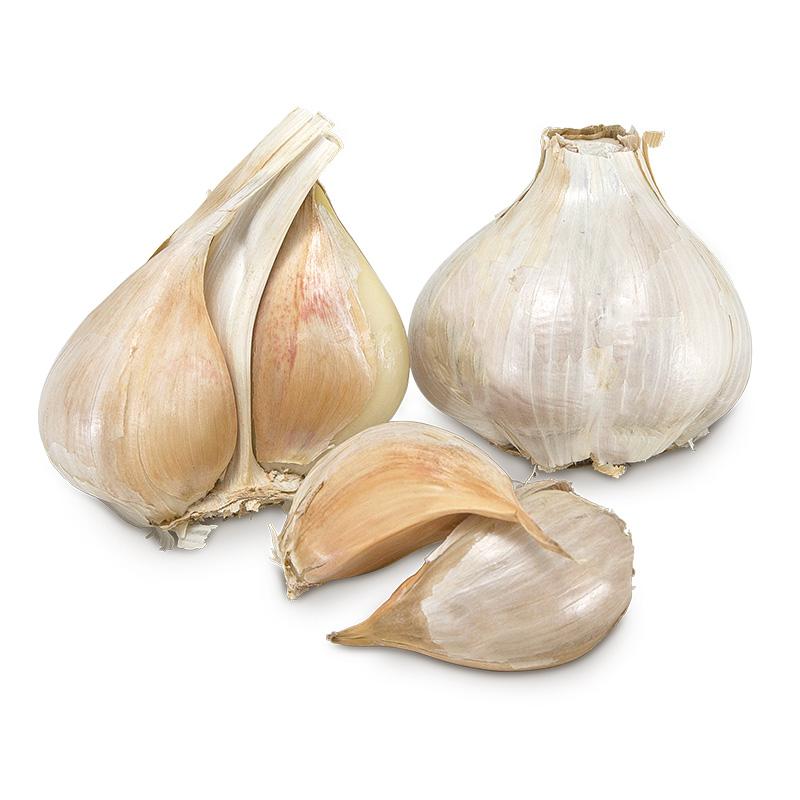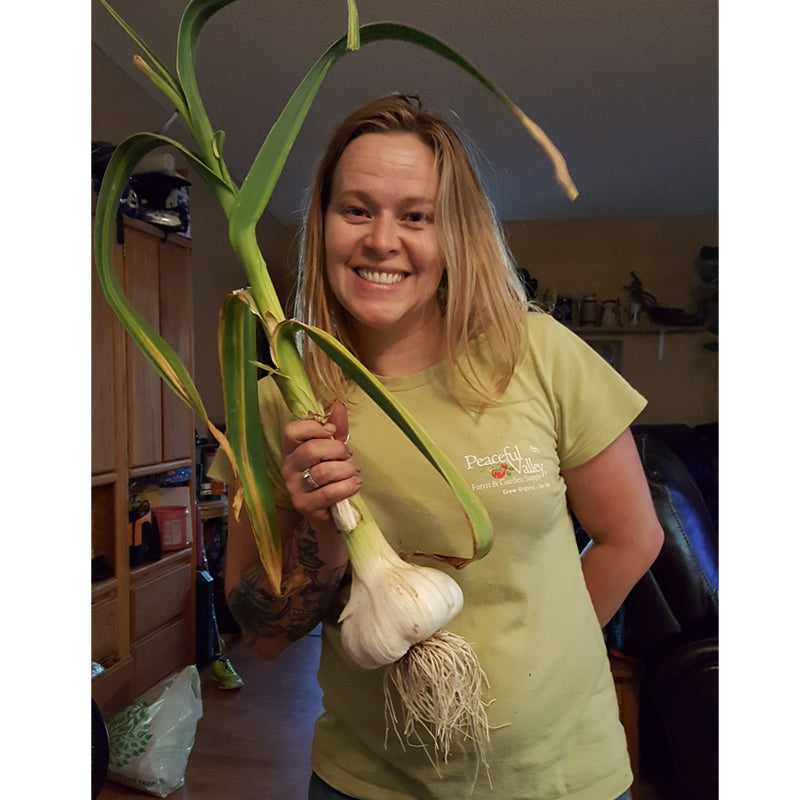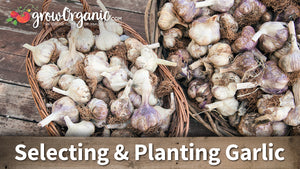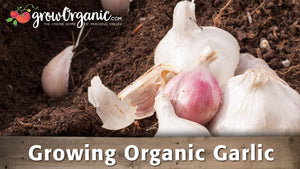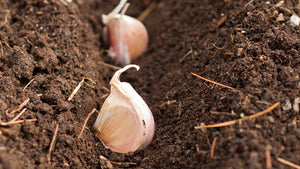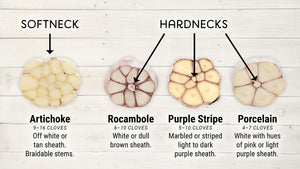Item Number: FP550
Conventionally Grown Garlic, Elephant (lb)
Conventionally Grown Garlic, Elephant (lb)
Mild Garlic Flavor That's A Great Keeper
- They call it Elephant because it gets so big! It looks, smells, and tastes like garlic but it's actually a member of the leek family. Cure for 30 days before using, or it will be bitter.
- Raw flavor is like an intense green onion with a garlic taste, but we recommend using this cooked, not raw.
- Delicious in chicken dishes, or as an onion or leek substitute in soups or stews.
- A great keeper, storing up to a year.
- Grows best where winters aren't too severe (sorry, Midwesterners). When raised in optimal conditions, this monster can be 4" across.
- Packaged as a combination of bulbs and individual cloves by weight. Approximately 1.5-2 bulbs per pound, 5-6 cloves per bulb
- Grown in California
Welcome to the world of growing elephant garlic, a unique member of the allium family renowned for its mild yet flavorful bulbs. In this guide, we'll explore everything you need to know about cultivating elephant garlic, from planting to harvest, and offer valuable tips for optimal growth.
Understanding Elephant Garlic
Elephant garlic (Allium ampeloprasum var. ampeloprasum) is often mistaken for regular garlic due to its appearance and taste. However, it belongs to the leek family and produces large, mild-flavored bulbs.
These bulbs, resembling oversized garlic cloves, offer a mild garlic flavor with hints of onion and leek. They are best enjoyed cooked rather than raw.
Climate and Soil Requirements
Elephant garlic thrives in regions with mild winters and cool summers. It prefers well-drained soil with good fertility and a pH level between 6.0 and 7.0.
While it can tolerate various soil types, loamy soil enriched with organic matter is ideal for optimal growth.
Elephant garlic thrives in various soil types, including clay soil and sandy soil, making it adaptable to different garden environments. Its tolerance for sand, silt, and clay ensures successful growth for gardeners facing diverse soil compositions. With its easy-to-grow nature and preference for full sun, elephant garlic is an excellent choice for gardeners seeking a low-maintenance, sun-loving plant for their garden beds or containers.
Planting Elephant Garlic
Plant elephant garlic cloves in the fall, approximately 2-4 weeks before the first frost date. This allows the cloves to establish roots before winter dormancy.
Choose large, healthy cloves for planting, ensuring they are firm and free from disease or damage.
Space the cloves 6-8 inches apart in rows with 12-18 inches between rows. Plant the cloves 2 inches deep with the pointed end facing up.
During the growing season, elephant garlic develops robust plant roots, anchoring itself securely in the soil. To promote healthy growth, ensure good drainage to prevent waterlogging, which can hinder root development. Planting individual cloves at the proper depth allows for optimal root establishment, setting the stage for a successful harvest of large, flavorful bulbs.
Care and Maintenance
Water the garlic regularly, keeping the soil consistently moist but not waterlogged. Reduce watering as the bulbs mature to prevent rot.
Mulch around the plants to conserve moisture, suppress weeds, and regulate soil temperature.
Fertilize the garlic with a balanced fertilizer high in nitrogen during the early stages of growth. Avoid excessive nitrogen as it can promote leafy growth at the expense of bulb development.
Harvesting Elephant Garlic
Elephant garlic typically matures in late spring to early summer, approximately 9-10 months after planting.
Monitor the foliage for signs of yellowing and drying, indicating that the bulbs are ready for harvest.
Carefully loosen the soil around the bulbs with a garden fork and gently lift them from the ground. Avoid damaging the bulbs during harvest to ensure optimal storage quality.
Curing and Storage
After harvest, allow the bulbs to cure in a well-ventilated, dry area for 2-4 weeks. This process helps enhance flavor and extends storage life.
Once cured, trim the roots and foliage, leaving a few inches of stem attached to the bulb.
Store the cured bulbs in a cool, dry place with good air circulation, such as a mesh bag or wooden crate. Properly stored, elephant garlic can last up to a year.
Common Pests and Diseases
While elephant garlic is relatively resistant to pests and diseases, it may still encounter challenges such as aphids, onion maggots, and fungal infections.
Monitor the plants regularly for signs of pests or disease, and promptly take action to mitigate any issues. Practices such as crop rotation and proper sanitation can help prevent problems.
Tips for Success
Plant elephant garlic in raised beds or containers if your soil is heavy or poorly drained.
Avoid overwatering, especially during the dormant period, as it can lead to rot and fungal diseases.
Consider companion planting with crops such as tomatoes, lettuce, or peas to maximize garden space and deter pests.
Growing elephant garlic can be a rewarding experience for gardeners seeking a flavorful addition to their culinary endeavors. By following these guidelines and tips, you can cultivate robust bulbs that are sure to impress with their mild yet distinctive flavor.For more information, see our Garlic Resource Center. Our staff have selected dozens of articles, videos, recipes and tips with everything you need to successfully grow garlic bulbs.
Please note: Elephant garlic will look different than other varieties of garlic on arrival. The cloves may have separated from the bulb and the papery skins may be peeling. This is completely normal and will not affect viability.



Check Your Zone Compatibility:
Compatible with your zone.
Growing Zone for
,

Our Guarantee To You
Since 1976, we've served our customers at every stage of growing. Please contact us at any time. We are happy to support and assist you.
Description
Description
- They call it Elephant because it gets so big! It looks, smells, and tastes like garlic but it's actually a member of the leek family. Cure for 30 days before using, or it will be bitter.
- Raw flavor is like an intense green onion with a garlic taste, but we recommend using this cooked, not raw.
- Delicious in chicken dishes, or as an onion or leek substitute in soups or stews.
- A great keeper, storing up to a year.
- Grows best where winters aren't too severe (sorry, Midwesterners). When raised in optimal conditions, this monster can be 4" across.
- Packaged as a combination of bulbs and individual cloves by weight. Approximately 1.5-2 bulbs per pound, 5-6 cloves per bulb
- Grown in California
Welcome to the world of growing elephant garlic, a unique member of the allium family renowned for its mild yet flavorful bulbs. In this guide, we'll explore everything you need to know about cultivating elephant garlic, from planting to harvest, and offer valuable tips for optimal growth.
Understanding Elephant Garlic
Elephant garlic (Allium ampeloprasum var. ampeloprasum) is often mistaken for regular garlic due to its appearance and taste. However, it belongs to the leek family and produces large, mild-flavored bulbs.
These bulbs, resembling oversized garlic cloves, offer a mild garlic flavor with hints of onion and leek. They are best enjoyed cooked rather than raw.
Climate and Soil Requirements
Elephant garlic thrives in regions with mild winters and cool summers. It prefers well-drained soil with good fertility and a pH level between 6.0 and 7.0.
While it can tolerate various soil types, loamy soil enriched with organic matter is ideal for optimal growth.
Elephant garlic thrives in various soil types, including clay soil and sandy soil, making it adaptable to different garden environments. Its tolerance for sand, silt, and clay ensures successful growth for gardeners facing diverse soil compositions. With its easy-to-grow nature and preference for full sun, elephant garlic is an excellent choice for gardeners seeking a low-maintenance, sun-loving plant for their garden beds or containers.
Planting Elephant Garlic
Plant elephant garlic cloves in the fall, approximately 2-4 weeks before the first frost date. This allows the cloves to establish roots before winter dormancy.
Choose large, healthy cloves for planting, ensuring they are firm and free from disease or damage.
Space the cloves 6-8 inches apart in rows with 12-18 inches between rows. Plant the cloves 2 inches deep with the pointed end facing up.
During the growing season, elephant garlic develops robust plant roots, anchoring itself securely in the soil. To promote healthy growth, ensure good drainage to prevent waterlogging, which can hinder root development. Planting individual cloves at the proper depth allows for optimal root establishment, setting the stage for a successful harvest of large, flavorful bulbs.
Care and Maintenance
Water the garlic regularly, keeping the soil consistently moist but not waterlogged. Reduce watering as the bulbs mature to prevent rot.
Mulch around the plants to conserve moisture, suppress weeds, and regulate soil temperature.
Fertilize the garlic with a balanced fertilizer high in nitrogen during the early stages of growth. Avoid excessive nitrogen as it can promote leafy growth at the expense of bulb development.
Harvesting Elephant Garlic
Elephant garlic typically matures in late spring to early summer, approximately 9-10 months after planting.
Monitor the foliage for signs of yellowing and drying, indicating that the bulbs are ready for harvest.
Carefully loosen the soil around the bulbs with a garden fork and gently lift them from the ground. Avoid damaging the bulbs during harvest to ensure optimal storage quality.
Curing and Storage
After harvest, allow the bulbs to cure in a well-ventilated, dry area for 2-4 weeks. This process helps enhance flavor and extends storage life.
Once cured, trim the roots and foliage, leaving a few inches of stem attached to the bulb.
Store the cured bulbs in a cool, dry place with good air circulation, such as a mesh bag or wooden crate. Properly stored, elephant garlic can last up to a year.
Common Pests and Diseases
While elephant garlic is relatively resistant to pests and diseases, it may still encounter challenges such as aphids, onion maggots, and fungal infections.
Monitor the plants regularly for signs of pests or disease, and promptly take action to mitigate any issues. Practices such as crop rotation and proper sanitation can help prevent problems.
Tips for Success
Plant elephant garlic in raised beds or containers if your soil is heavy or poorly drained.
Avoid overwatering, especially during the dormant period, as it can lead to rot and fungal diseases.
Consider companion planting with crops such as tomatoes, lettuce, or peas to maximize garden space and deter pests.
Growing elephant garlic can be a rewarding experience for gardeners seeking a flavorful addition to their culinary endeavors. By following these guidelines and tips, you can cultivate robust bulbs that are sure to impress with their mild yet distinctive flavor.For more information, see our Garlic Resource Center. Our staff have selected dozens of articles, videos, recipes and tips with everything you need to successfully grow garlic bulbs.
Please note: Elephant garlic will look different than other varieties of garlic on arrival. The cloves may have separated from the bulb and the papery skins may be peeling. This is completely normal and will not affect viability.
View our entire seed garlic collection!
Shipping Information
Shipping Information
We cannot delay ship garlic/shallots. They will be shipped as soon as they are in stock.
Cannot ship to the following states: HI, PR, VI, ID, GU, AK
Shipping Weight: 1.05 lb
Dimensions: 5.0"L x 3.0"W x 3.0"H
Features
Features
- Bulb
- Container Compatible
- Easily Established
- Easy to Peel Cloves
- Good for Beginners
- Good Keeper
- Mild Flavor
Characteristics
Characteristics
Planting & Care
Planting & Care
Useful Information
Useful Information
Guarantee
Guarantee
Limited Seed Garlic Guarantee (When Planted by November 15th)
Claim Deadline is 45 Days from Purchase or Delivery. (Claims placed after December 31st will be denied.)
What We Guarantee
Our only guarantee is that the seed garlic we sell will germinate, provided you follow the steps listed in our Garlic Planting & Growing Guide. This guarantee is only available to customers who purchase their seed garlic directly from us.
What We Cannot Guarantee
We cannot guarantee that your garlic will remain alive & healthy, or sizes up properly, as there are too many variables beyond our control to be able to do so (i.e. soil preparation, fertilization, weed and pest control, temperature control, irrigation, etc).
How to Request a Credit
If you encounter a significant lack of germination of your garlic (over 50%), please contact us within 45 days of delivery. If we determine that your garlic had a significant lack of germination, we will issue you a credit (not a refund) for the purchase price of your garlic (excluding shipping).* This 45-day time frame is meant to allow you up to 2 weeks to plant your garlic, and up to 4 weeks to check for signs of growth.
(*) We reserve the right to not issue credit for items already replaced. We also reserve the right to require photographic evidence of the lack of germination of your garlic.
Share
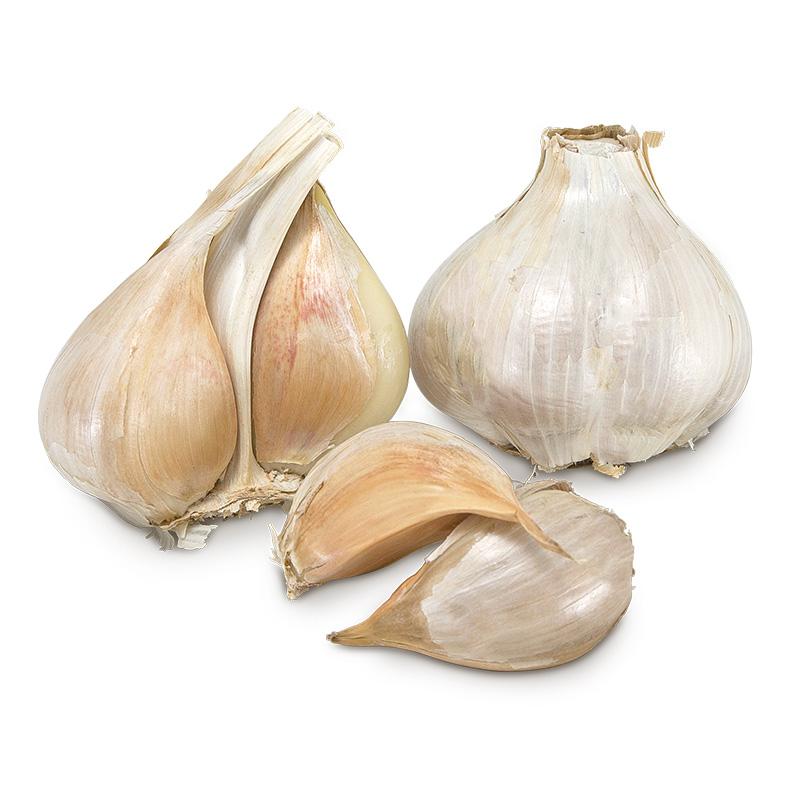
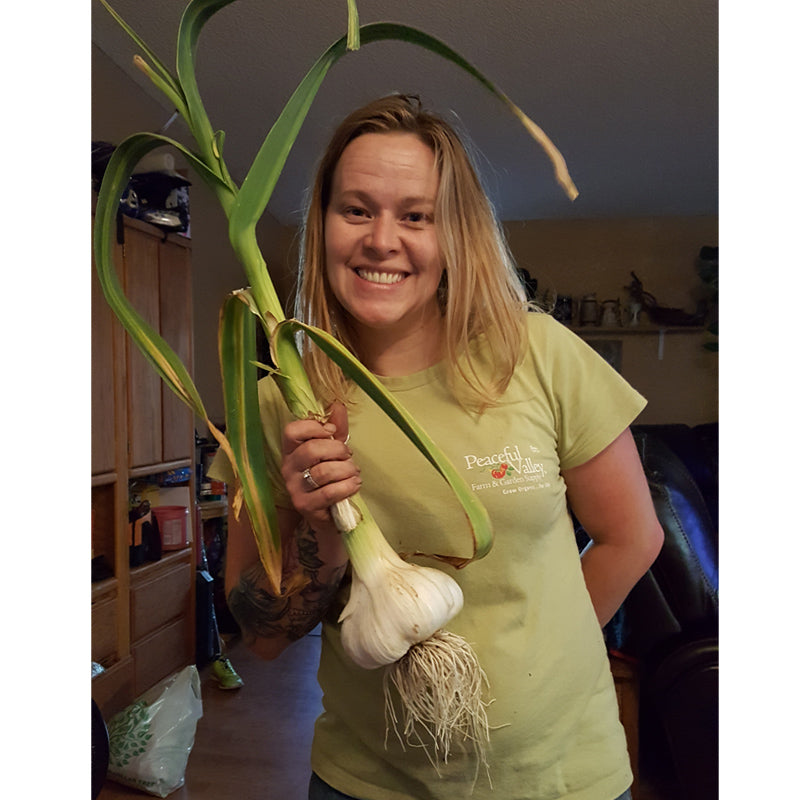
Very impressed with the size and quality of these elephant garlic heads, no obvious signs of disease or damage on a single clove. You can tell how healthy are ready to go each clove is as soon as you break it off the bulb. Rooted quickly and is already popping up with strong growth.
BEAUTIFUL Garlic Heads. VERY Large and healthy. I am anxious to see how well they do. I have been shopping at Peaceful Valley for more than 15 years. I have Never been disappointed. Excellent products and customer service. I am always finding something new to grow.
Peaceful Valley offers so much helpful information. (A wealth of information) I can’t Thank all of your staff enough.
These thing are huge and arrived in great condition. Got 3 heads plus 3 cloves for 1 LB
The bulbs arrived quickly and the size was amazing. Beautiful healthy cloves perfect for planting for huge finished bulbs. The bulbs took no time to root and the plants are looking amazing. Can't wait until these plants are done!
Huge bulbs, all in good condition, no rot. Everything is growing, can't wait to harvest!

